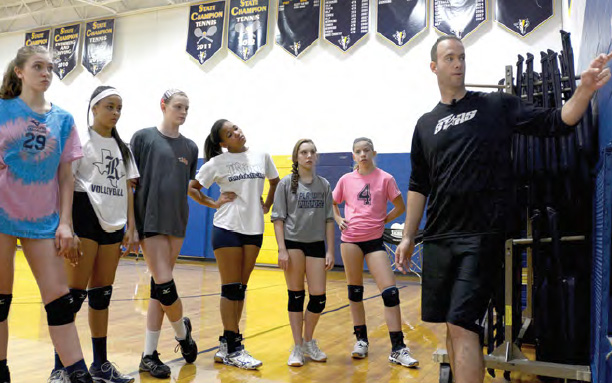| The Cure for PTSD (Play Time Stress Disorder) |
| By: Leon Blazer
Originally Published in: Coaching Volleyball - Provided by: AVCA
They see all the faults in the other kids and only the good plays of their own daughter. When you bring up the missed serve on game point, the response is "Well, she made the rest of her serves" or "She was looking to you for direction and you weren't paying attention." I'd like to think if the roles were reversed, I would be the model parent ... right? My daughter is 16 months old and I can only hope that she takes up this great sport. I'd like to think that I could be the perfect team parent and not offer up unsolicited advice from my "expert" perspective. I'll have a follow-up to this in January 2031 issue. The challenge to create a positive playing time culture is no easy task. And no situation is the same, so in offering up these suggestions, I in no way am taking anyone's situation lightly. But year after year I find that I have relatively few problems with the playing time issues. It can be done.
Here are some key points to developing a strategy to avoid PTSD. 1. You have to have a clearly defined playing time philosophy. You cannot tell a kid and her parents that she isn't going to play all weekend if you haven't established your team as a "Non-equal Playing Time Team." Here is how I define each type. a. Non-equal PT Team/Competitive — I reserve this for my non-developmental teams. Most of the teams in my club fall under this heading. I tell the parents that it is an "Equal Practice" and "Equal Opportunity" team, but not equal game time. The goal of the team is to win every game that it has the chance to win. b. Somewhat Equal Play Time — I lean more toward this model with my local/developmental teams. I tell the coaches that if they have a chance to win a match, then they can alter the PT a bit. But if a player does not play in an entire match, they have to be in the game for the next match. Parents are told to define success in the individual growth vs. the W-L column. c. Completely Equal Play Time — This model is mostly for strictly developmental teams that operate outside the normal club structure. Teams rotate as they normally would in a game, but the player from LB rotates to the back of the bench, and the person in front of the bench rotates to LF. Or they can rotate out after being a server, or however you define it. It doesn't follow normal subbing rules, so it is strictly for those teams and the tournaments that allow those rules for that level. 2. Give the kids defined roles. One thing I have found that is really discouraging to a kid is not knowing what the heck they are supposed to do. They sit there with no anticipation or excitement for their chance to use their skills (even limited ones) to contribute to the team. I have called kids everything from serving specialist to supreme hustler to great motivator, to tip coverage master. I used a rotation and a half to prepare my Tip Coverage Master to tell her exactly what to look for (and just stand behind the block). You will find that a player who is happy about her role, even if diminished, will show that joy to her parents and they will be less inclined to bend your ear over PT. I had another team that I was helping out with. They were struggling to pull ahead against a team they were slightly better than. The coach was asking me what to do with a kid who hadn't been in and they didn't have a cushion. This was not the most competitive team so there were expectations that kids would get opportunities to play. I asked what the kid was good at, and the coach said serving. My advice was to find a position for her to serve in and get her in. The point of the story goes far beyond the fact that the player went back and served eight straight points to win the match. I told the coach that in that moment, she needed to make that kid the hero of the match. Only by her "awesome" serves were they able to pull out of the stalemate they were in and win the game. I saw a kid who was down in the dumps on the sideline and a clearly upset parent both flip a 180 and celebrate the moment. In the end, she didn't play much at all. But her role was seemingly momentous and that was far more important than how long her feet were on the grid. 3. Give them the chance for success. This was a big problem that I saw early on in my coaching career and it took a non-coach who was an avid observer of D-I volleyball to call me out on it. What happens when you beat a team 25-7 in the first set? We get all wide-eyed and think "YEEESSSSS!!! (double fist pump) ... Now I can get #3 in the game. We are sure to win the next set ... actually ... since we are so sure to win ... how about I get #7 in for #12, move #12 to RS, have my setter play Libero because she wanted to try it out, Put #2 ... NO, #5, in as my other middle blocker and let #10 set ... yeah, that should do it. Then when your team takes the court with utter confusion and finds themselves down by 10 points, you start yelling, and now #3, who has waited patiently for three matches to get in, has a horrible experience. Back to my avid observer. He said "Coach Leon, I won't tell you your business. I'm just a salesman. But I watch a lot of University of Washington women's volleyball, and I notice that Coach McLaughlin almost never subs in a reserve unless the match is clearly under control." Duh. So give #3 a chance to be successful. When you make lineup changes to get a kid in, put them in with the rest of the starters. I might make two adjustments to get kids in against a team I'm sure I'll beat. Never three.
4. Make a plan of attack. This one could raise some controversy. I believe there are matches that cannot be won. I think there are some that should be an easy win and there are a lot in the middle of the two. Let's take day one of a tournament. You are third in your pool of four. First in your pool is ABC 14 Elite. The second-place team is one you think you can beat, and the fourth is a team you should beat easily. Usually you need to take first or second in a pool to advance in the higher rounds. So you have a game you should win (vs. number 4), a game you must win (vs. number 1 or 2) and the other of those two is not as important. You also are in a situation where you need to get some kids on the court. A lot of coaches would try to get the reserves in vs. the fourth-place or second-place match. But I would argue that if you are compelled to get kids on the court, then play them against the first-place team. Here's why. Say you watch ABC 14 Elite warming up. Not only are they big, but they can pass, have coordinated movements, and bounce the attack line to boot. This is one of those matches where you score about six points. You simply are not at a developmental level to compete with them. But your kids need to find some court time. So save the best lineup for the second-place match. Make sure you are clearly ahead of the fourth-place match before putting reserves in, and try something new against the first-place team. Get a couple kids in, or work in a lineup you have wanted to try out. 5. Give them Goals. I think a player needs to know what their expectations are and if they aren't playing much, what they can do to improve and get some PT. A while back one of my 12s was wanting some reps as a setter. I have a pretty strict policy that a player doesn't get to set if they can't get their serves in the court. They are usually my first server and need to establish the rhythm of the match by not sending it into the net ... or the back of the middle blocker's head. She struggled mightily with being consistent with her serve. Out of five serves, one or two were in, one was close, and two were complete misses. I told her at one practice that she would never set for me if she didn't focus on getting her serves in the court. At the time she was devastated, but she was also determined and in time her serve got better and better. I rewarded her efforts with more opportunities to set. Did she ever miss a serve? Sure. But she was closer to my 10% error acceptance, and she almost never missed her first serve from behind the line. I believe these keys can be helpful but they apply more to the younger age groups. At some point we have to take the teams beyond the hand-holding and teach them the hard lesson that not everything is fair on the court. But at the younger ages, they need court time to learn and grow. It is definitely easier if your team is ranked near the top each tournament. But I've also sat with many teams where they were in that middle ground, and I found these keys to be helpful to the coaches I worked with and their players. There will always be playing time issues. But they can be minimized. And you can find ways for your players to play, even on those "Non-equal PT Teams." |









